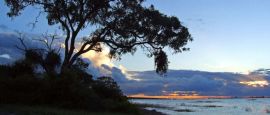Botswana Weather, climate and geography
Weather & climate
Botswana has a semi-arid climate, with hot, sunny days and cooler nights for most of the year. The country experiences four main seasons, although temperatures and rainfall can vary by region.
Spring (September to November): This is one of the hottest periods of the year, with daytime temperatures often reaching 30°C to 40°C (86°F to 104°F). Rainfall begins to increase towards November, especially in the north.
Summer (December to February): The rainy season peaks during these months, bringing short, heavy showers and occasional thunderstorms, especially in the afternoon. Temperatures typically range from 25°C to 35°C (77°F to 95°F), with high humidity in some areas. The landscape becomes green and lush, and wildlife is more dispersed.
Autumn (March to May): Rainfall decreases, and temperatures start to cool. Days are still warm, averaging 25°C to 30°C (77°F to 86°F), while evenings become more comfortable. It's a good time to travel, with fewer tourists and clear skies.
Winter (June to August): This is the dry season and the most popular time for wildlife viewing. Daytime temperatures are mild, between 20°C and 25°C (68°F and 77°F), but nights can be chilly—especially in the desert and at higher elevations, where temperatures may drop below 5°C (41°F).
Overall, Botswana receives the bulk of its rainfall between November and March, while the dry season (April to October) is cooler and better suited to game viewing due to sparse vegetation and limited water sources.
Clothing in Botswana should be lightweight, breathable, and suited to the country’s predominantly hot and dry climate. Natural fabrics such as cotton and linen are ideal, particularly during the warmer months from September to April. Neutral colours like beige, khaki, and olive are recommended for safari activities, as they blend into the environment and do not attract insects.
For the cooler winter months (June to August), it's important to pack layers. While daytime temperatures are comfortable, mornings and evenings can be cold—especially in desert areas. A warm fleece or jacket, long trousers, and a woollen hat or gloves may be needed if you're camping or going on early morning game drives.
During the rainy season (November to March), a lightweight waterproof jacket or poncho is useful, as showers can be sudden and intense. Quick-drying clothes and a pair of waterproof shoes or sandals with good grip are also advisable.
Comfortable walking shoes are essential for game walks or sightseeing, while a wide-brimmed hat, sunglasses, and high-SPF sunscreen offer protection from the strong African sun.
In urban settings, casual dress is acceptable, but modesty is appreciated, especially in rural areas and religious or traditional settings.
Geography
Located in the heart of southern Africa, Botswana is a landlocked country known for its wide-open spaces, dramatic skies, and diverse natural landscapes. It shares borders with Namibia to the west and north, Zimbabwe to the northeast, Zambia at a single point near Kazungula, and South Africa to the south and southeast.
Much of Botswana lies on the Kalahari Plateau, a vast expanse of semi-arid savannah and sandveld that covers around 70% of the country. Despite its name, the Kalahari isn't a true desert—it supports a surprising amount of wildlife and vegetation, especially after the rains.
The most iconic geographic feature is the Okavango Delta in the northwest—a vast, seasonally flooded wetland and UNESCO World Heritage Site where water from Angola's highlands fans out and disappears into the sands. It's one of the few inland deltas in the world and a magnet for wildlife and birdlife.
To the northeast lies the Chobe River floodplain, lush and green in contrast to the surrounding dryland, while central Botswana is home to the Makgadikgadi Pans, one of the largest salt flats on Earth—otherworldly in the dry season and teeming with life during the rains.
The highest point in Botswana is Monalanong Hill, near the capital Gaborone, rising to about 1,494 metres (4,902 ft) above sea level. The lowest point is the junction of the Limpopo and Shashe Rivers, at around 513 metres (1,683 feet).
For travellers, Botswana's geography is as much about the atmosphere as the terrain—from moonlit salt pans to water-laced reed beds, rolling acacia woodlands, and sun-baked savannah. It's a country where space is plentiful, wildlife still roams freely, and the land itself is a central part of the experience.
Do you have any Feedback about this page?
© 2025 Columbus Travel Media Ltd. All rights reserved. No part of this site may be reproduced without our written permission, click here for information on Columbus Content Solutions.




 You know where
You know where